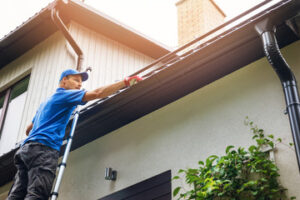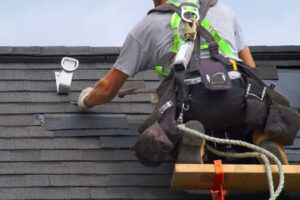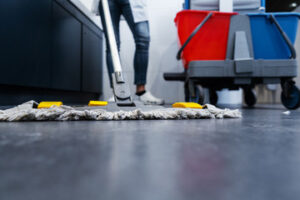Gutter Cleaning is an essential maintenance task that safeguards a home’s foundation and structural integrity. Regular gutter cleaning removes debris, clogs, and standing water to ensure unobstructed flow off the roof and prevents damage.
After a thorough inspection and identifying trouble spots, technicians mount ladders equipped with safety gear to tackle the job. Then, high-powered blowers unleash a powerful airstream that blasts away leaves and twigs while clearing downspouts of any blockages. Visit https://www.stlouisguttercleaningservices.com/ to learn more.

Gutters seem like an inconspicuous part of a home’s exterior, but they play a vital role in protecting the foundation and structural integrity of a building. Clogged gutters prevent the proper flow of rainwater, which can lead to a number of problems that can be costly to fix.
Rainwater that collects around a building’s foundation can cause settlement and cracks to develop over time. Gutters help prevent this by collecting and redirecting rainwater away from a building’s foundation and landscaping.
The proper flow of rainwater is also important to the health of a house’s roof and structure. Rainwater that isn’t properly channeled can saturate the soil underneath shingles, lifting them and causing wood rot. The water can also seep into basements and crawl spaces, resulting in dampness and mold growth. Gutters that are regularly cleaned prevent this from happening, ensuring that water is properly channeled and preventing moisture damage to the structure of a home.
In addition to the issues listed above, clogged gutters can create the perfect breeding ground for pests like mosquitoes and rodents. Mosquitoes lay their eggs in stagnant water, and rodents seek shelter in the debris and twigs that clogged gutters can provide. Regular gutter cleaning can keep these pests away from a home, preventing them from creating breeding grounds and posing a risk to the health and safety of household members.
Gutter cleaning is an easy task that can be performed by homeowners, although it’s recommended that they use ladder safety principles, including keeping their body between the side rails and working on level ground. Those that don’t feel comfortable doing this themselves can hire professional gutter cleaners. Regardless of how the job is performed, it’s essential to maintain this maintenance routine to avoid expensive foundation damage and other costly repairs. It’s also a great way to protect a property’s curb appeal and make it look well-maintained and healthy.
Prevents Water Damage
Gutters play a vital role in protecting your property from water damage. When they’re working properly, gutters direct rainwater away from foundations, walls and roofs, preventing soil erosion and basement flooding. However, if your gutters become clogged with debris, they can’t perform their job, and this can lead to water infiltration that causes structural damage. Regular cleaning can help prevent this damage, saving you from costly repairs in the future.
Water infiltration also increases your risk of mold growth. Moist environments encourage the growth of fungus, which can destroy shingles and underlayment, and leak into the house. In addition, leaking water can cause wood damage, rot and staining on the roof and walls of your home. By keeping your gutters clean and free of debris, you can reduce the risk of water infiltration and protect your property from damage caused by mold and fungus.
Gutter cleaning also protects your landscaping and exterior features. If your gutters are clogged, water can overflow and spill onto walkways and driveways, causing them to become eroded and damaged. Additionally, clogged gutters can cause water to back up under the roof, destroying shingles and ceilings.
Clogged gutters can also be a breeding ground for pests, attracting mosquitoes and other insects that can carry harmful diseases. In addition, stagnant water in clogged gutters can become an ideal environment for rodents like squirrels and rats. Gutter cleaning can prevent pest infestation by removing their habitat and keeping water flowing freely.
In addition to protecting your home, gutters can also help protect the environment by reducing the amount of rainwater that flows into streams and rivers. This is important in areas with high rainfall, as too much water can cause flooding and water pollution. Regular maintenance and cleaning can ensure that your gutters are working as they should, directing water away from your home and into the ground where it belongs. Gutter cleaning can also save you money on expensive waterproofing treatments and remediation services. As the old saying goes, an ounce of prevention is worth a pound of cure.
Prevents Pest Infestation
Gutters are designed to funnel rainwater away from structures, ensuring their longevity and safeguarding landscapes and foundations. But clogged gutters can cause water-related damage to the roof, foundation, and structure of buildings. In addition, they serve as breeding grounds for pests. Regular gutter cleaning prevents clogs, water overflow, and pest infestation.
Gutter debris – including leaves, twigs, and branches – provides nesting materials for pests like birds, mice, rats, and mosquitoes, which can carry deadly diseases. In addition, clogged gutters decompose to form organic material that supports the growth of fungi, tree seedlings, and weeds. These invasive plants can damage your roof and overtake your landscaping, making them a nuisance. Regular gutter cleaning eliminates these breeding areas and keeps the ecosystem around your property healthy and thriving.
Standing water in clogged gutters serves as a magnet for mosquitoes and other pests, which breed in the stagnant water and spread disease to humans and pets. Regular gutter cleaning removes this breeding ground and discourages pest infestations from developing in your home or office. In addition, you should trim back any bushes or trees that are too close to your building and regularly mow your lawn to eliminate the opportunity for pests to enter your living spaces.
Gutter cleaning is a dirty, time-consuming task that requires the use of ladders and power tools. However, it’s a crucial part of safeguarding your property and improving the aesthetic appeal of your home or business. Professional gutter cleaners have the experience, skillset, and specialized equipment to quickly clean your gutters while eliminating the risk of injury and damage. They’ll also leave your gutters looking like new, saving you the time and money it takes to replace damaged gutters.
The benefits of proper gutter maintenance are endless. Regular cleaning and servicing reduces wear and tear, minimizes blockages, and extends the lifespan of your gutter system. Gutter cleaning also protects your landscaping and foundation, prevents mold growth, and improves the appearance of your property. In addition, hiring professionals to perform this important task ensures that your gutters are free-flowing and properly functioning.
Prevents Mold Growth
Clogged gutters trap water against the roof structure, causing wood rot and lifting of shingles. Water also seeps into basements and crawl spaces, resulting in flooded areas, mold growth and damage to belongings stored in these areas. Regular gutter cleaning prevents overflow and channeling of water away from the house, preventing structural damages as well as protecting contents from mold and mildew.
Gutter cleaning is a messy job that involves climbing and working on ladders, so protective gear is recommended. Rubber-soled shoes are a good choice, as they grip better on the rungs or steps of ladders than sandals. It is best to work with an experienced partner, especially if you are not used to climbing ladders. It is recommended to always wear eye protection, as debris from clogged gutters can be very dangerous. It is also important to follow ladder safety protocol, such as keeping the body between the side rails and working on level ground whenever possible.
Another benefit of regularly cleaning your home’s gutters is that it helps to keep humidity under control. Mold thrives in damp conditions, and mold spores can trigger respiratory issues like chronic coughing or irritated eyes. Keeping the humidity in your home below 50% will starve mold, preventing it from growing and spreading throughout your living spaces.
Preparing for a gutter cleaning ahead of time can also help streamline the process and ensure it is done thoroughly. Clearing out any obstructions or impediments will allow technicians to reach the gutters more easily and efficiently, while marking areas that may have persistent clogs or signs of damage will alert them to pay special attention to these spots during the cleaning process.
Gutter cleaning is a service that every homeowner should consider in order to protect their property, avoid costly repairs and maintain the value of their home. A professional cleaning company provides a comprehensive service, from emptying and rinsing the gutters to cleaning and restoring fascia boards, using high powered water fed pole technology. By regularly cleaning the gutters and preventing clogs, you can help prolong the lifespan of your roof, ensuring it serves you well for years to come.



